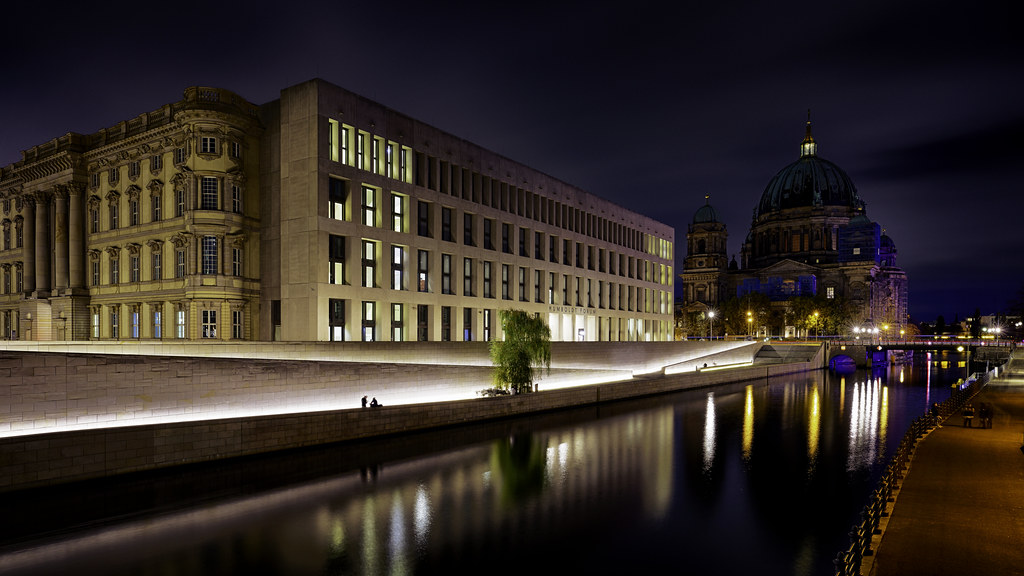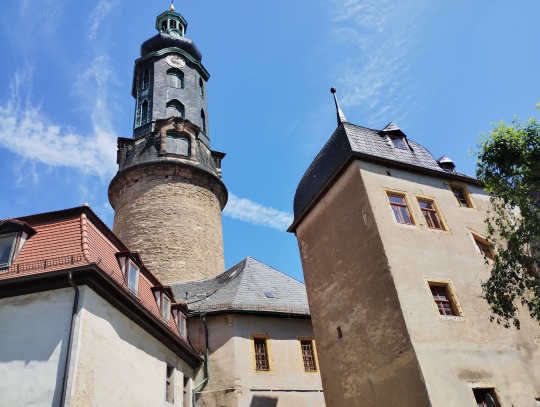#Stadtschloss
Text
Interview with a Ghost, or: Royal Ghost Hunters
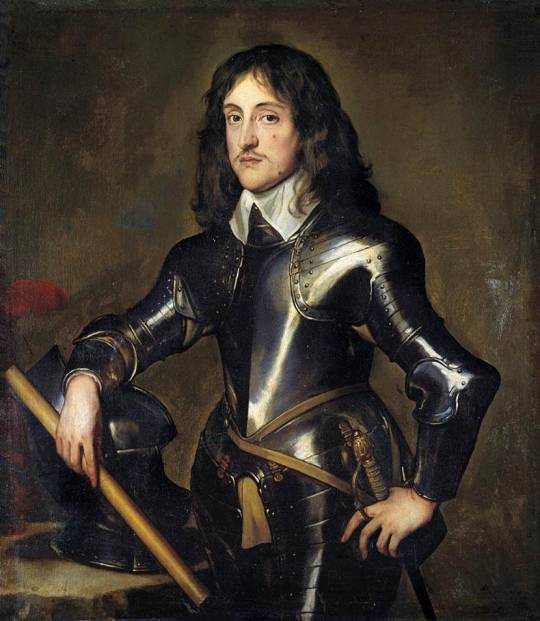
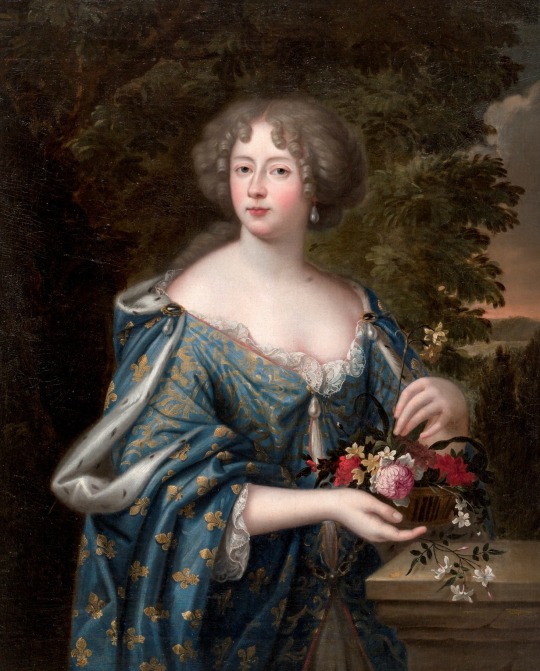

Left to right: ghost hunters Karl Ludwig I. Elector Palatine (1617–1680), his daughter Liselotte von der Pfalz, Duchess of Orleáns (1652–1722), and Friedrich Wilhelm I., King in Prussia (1688–1740).
Since it’s Halloween, I thought I should make a themed post! And what better topic to choose than ghosts? But more often than not, these restless souls wandering between the worlds, preferably at night, are of an entirely earthly origin— especially when bedsheets are involved.
Haunted more by a family history of trouble and turmoil than actual ghosts, let’s look at three Stuart descendants and their brush with the allegedly supernatural:
Karl Ludwig, Elector Palatine and the Ghost of Chain Alley
This first story of a successful ghost hunt concerns Karl Ludwig, Elector Palatine, and was passed from Liselotte von der Pfalz to her much younger half-sister Luise on 22 February 1721.
Zu Heidelberg, ehe Ihr geboren, wurd ein groß Geschrei von einem Gespenst, so alle Nacht mit feurigen Augen und großem Geplärr durch die Kettengaß ging. Ihro Gnaden, der Kurfürst, unser Herr Vater, ließ dem Gespenst aufpassen und fangen; da ertappte man drei oder vier Studenten, so Franzosen waren. — Einer, so Beauregard hieß und des Generals Balthasar Schwager war, der war das Kalb, und die andern, ich glaube Monsieur Dangeaus Bruder, Coursillon, so jetzt Abbé ist, halfen zu der Musik. Wenn man die Gespenster genau examiniert, kommt als so was heraus.
From: Künzel, C. [Ed.], Die Briefe der Liselotte. Liselotte von der Pfalz, Herzogin von Orleans, München 1923, p. 442.
Translation:
[…] At Heidelberg, ere you were born, there was great upheaval on account of a ghost, which would go through the Kettengasse [literal translation: Chain Alley] each night with fiery eyes and a great clamour. His Grace the Elector our father had the ghost waylaid and captured; they caught four students, who were Frenchmen. – One of them by the name of Beauregard was the brother-in-law of General Balthasar, was the calf and the others, I believe the brother of Monsieur Dangeau, Coursillon, who is an abbé [abbot] now [among them], helped make the music. If only you examine ghosts closely, that’s what you’ll uncover.

The location of the Kettengasse in Heidelberg, via Google Maps. Conspicuously close to university buildings, it probably was not hard to guess that the ghost was a student hoax.
The Ghost of the Poisoned Princess: Liselotte Investigates

Henrietta Anne (1644–1670), first wife of Philippe, Duke of Orléans in a posthumous portrait by Peter Lely, and rather fittingly dressed in a white gown.
As can be seen from the story relayed to her half-sister, her father's no-nonsensical attitude set the tone for Liselotte’s own approach to ghostly apparitions— some stories, such as the ghost wandering the conspicuously aptly named Kettengasse, just seem too good to be true.
While not directly involved in the ghost hunt itself, Liselotte, a no-nonsensical person who did not believe in organised religion at large and superstition in particular, remained unphased when a ghostly apparition quickly identified as the wronged and restless soul of her husband’s first wife Henrietta Anne of England started to appear on occasion in a specific spot in the gardens of her residence, Saint Cloud palace. Liselotte, while occasionally chiming in on the rumours that Henrietta Anne may have been poisoned by the Chevalier de Lorraine, her husband’s favourite and her personal arch-nemesis, would have nothing of it and even interviewed the ghost in person:
Es gieng vor vielen Jahren ein Geschrey zu St. Cloud, daß feue Madame Geist im Garten bei einem Brunnen gienge, wo sie sich in der größten Hitze aufgehalten, den der Ort ist sehr kühl. Als des Marêchal de Clerembeaut Lakey Abends wie die Sonne untergegangen war, an dem Brunnen gieng Wasser zu schöpfen, sahe er etwas weisses an dem Brunnen sitzen ohne Figur, das stehet gegen ihm auf, und wird noch einmal so groß; der arme Lakey erschrack und lief weg, wie er aber weiter kam, sagte er: er hätte Madame gesehen, wurde tod krank und starb, der aber damals Capitaine du Chateau war, und wohl denken konnte, daß man dahinter stecken müste, gieng etliche Tage nachher auch zu dem Brunnen, und wie er das Gespenst gehen sahe, drohete er dem Gespenst 100 Prügel zu geben, wofern es nicht sagte, wer es wäre. Das Gespenst sagte: ah! Monsieur de Lastera, ne me faites point de mal, je suis la pauvre Philippinette. Diese war ein alt Weib aus dem Dorfe von 77 Jahren, die keinen Zahn mehr im Maule hatte und böse Augen, einen feuerroten Bord darum, ein groß Maul, eine große Nase; Summa se war abscheulich. Man wollte sie in ein Gefängnis führen, ich bat aber für sie. Sie kam mir zu danken; ich sagte: quelle rage Vous tient de faire l’esprit au lieu de Vous aller coucher? Sie fieng an zu lachen und sagte: je ne puis avoir regret à ce que j’ai fait; à mon âge on dort peu. Il faut bien avoir quelque petite chose pour reveiller l’esprit. Tout ce que j’ai fait dans ma jeunesse ne m’a tant rejouï, que de faire l’ésprit. J’étois bien sure, que ceux qui n’auroient pas peur de mon drap bla[n]c, auroient peur de mon visage. Ceux qui avoient peur, faisoient tant de grimaces, que j’en mourrois de rire. Ce Plaisir nocturne me payoit de la peine d’avoir porté la hotte toute la journée. Den 17ten Novembr. 1716.
From: Veltenheim, August F. von [Ed.], Anekdoten vom Französischen Hofe vorzüglich aus den Zeiten Ludewigs des XIV. und des Duc Regent: aus Briefen der Madame d'Orleans Charlotte Elisabeth, Herzog Philipp I. von Orleans Witwe Welchen noch ein Versuch über die Masque de Fer beigefügt ist, Strassbourg 1789, p. 291 f.
Translation:
Many years ago at St. Cloud, there was a rumour that the ghost of the late Madame [Henrietta Maria of England, first wife of Philippe d’Orléans] was pacing beside a well where she had dwelt in the greatest heat, because this place is exceedingly cool. When a lackey of the Marshal de Clerembeaut went to the well one evening to draw water, he saw something white and shapeless sit beside the well, which, facing him, rose and doubled in size; the poor lackey was startled and ran away, and as he got away, said that he had seen Madame, [then] fell fatally ill and died. But the person who was Capitaine du chateau [steward of the palace] at the time, having decided that one should ascertain what was behind all this, afterwards went to the well for several days as well, and upon seeing the ghost, threatened them with 100 lashes if they would not tell him who they were.
The ghost said: “Ah! Monsieur de Lastera, do me no harm, I am the poor Philippinette.” She was an old woman from the village who was 77 years old and had not a tooth left in her mouth and bloodshot eyes with red circles around them with a big mouth and a big nose and was therefore, all things considered, hideous.
They wanted to take her to prison, but I interceded on her behalf. She came to thank me; I said: “What came over you to try and be funny instead of going to sleep?”
She started to laugh and said: “I cannot regret what I have done; at my age, one sleeps little. One has to have a little something to raise one’s spirits. Everything that I have done in my youth has not delighted me as much as playing the spirit. I was quite certain that those who would not be afraid of my white sheet would be afraid of my face. Those who were afraid made such grimaces that I was dying of laughter. This nocturnal pleasure repaid me for the strain of having carried the hood all day.”
17 November 1716.
It's quite telling that she's punning on the phrase faire de l'ésprit, i.e. trying to be witty or funny (with ésprit also meaning spirit). Clearly, she was more amused than annoyed by Philippinette's prank, which stands in stark contrast to the next ghost hunter:
Friedrich Wilhelm I. in Prussia vs. 3 (!) White Ladies
Skipping a few generations down the family tree to the grandson of Liselotte’s favourite aunt Sophie von Hannover, for Friedrich Wilhelm, father of Frederick the Great, King in Prussia, the ghostly appearance of a woman in white announcing his father’s death in 1713 was less accidental than expected. Since generations, it was rumoured that the apparition of the ghostly figure known as the White Lady announced the death of a member of the Hohenzollern family. To name but some of the most prominent recent deaths in the family, the White Lady was rumoured to have been spotted just before the death of his grandmother Louise Henriette of Orange in 1667, grandfather Elector Friedrich Wilhelm in 1688 and their infant son Wilhelm Heinrich in 1649.
The ghost known as the White Lady was long rumoured to have been the unhappy ghost of a woman called Kunigunde von Orlamünde, a 14th century widowed noblewoman who was said to have fallen in love with a much younger man and member of the Hohenzollern family, Albrecht der Schöne [Albrecht the Beautiful]. Albrecht, or so the story goes, wanted to marry her, but faced fierce opposition from his parents, prompting him to say that four eyes stood in the way of their happiness. Kunigunde, misinterpreting her lover’s words, proceeded to murder her two children from her first marriage, thinking they were the two pairs of eyes Albrecht had alluded to. Having murdered her children, the penitent, lovestruck Kunigunde supposedly attached herself permanently to Albrecht’s family after her death. Research done in the 19th century however reveals that Kunigunde was childless, and that her only relationship with Albrecht was one of business, having bought land from him on which she built Himmelthron abbey, as whose abbess she died in 1382.
Another possible inspiration for the White Lady, particularly when seen in the Stadtschloss in Berlin, was Anna von Sydow, mistress of Elector Joachim II of Brandenburg (1505–1571), who died unhappily after having been incarcerated by her lover’s son and successor, to whom she is said to have appeared in her ghostly form to announce his approaching passing.

Epitaph of Kunigunde von Orlamünde as abbess of Himmelthron and a portrait said to depict Anna von Sydow, two women whose names are tethered to the myth of the White Lady of the Hohenzollern family.
Whether there is one definitive inspiration for the White Lady or not, the apparition visiting Friedrich I. on his deathbed was however of an altogether worldlier nature; this White Lady’s name was Sophie Luise zu Mecklenburg-Schwerin— and Friedrich’s third wife.

Friedrich I., King in Prussia.
For some time prior to Friedrich’s death, Sophie Luise’s mental health had deteriorated to such a degree that the Queen was considered insane by contemporaries. What had initially begun with a journey to finding personal religious fulfilment in Pietism and fights with Friedrich over which (Protestant, naturally) denomination was the ‘right’ one, developed into depression and at last, periods of aberration and complete disconnect from the world around her, prompting Friedrich to seek at least spatial separation from her.
One night in the months leading up to his death, Friedrich awoke in his chamber in the Stadtschloss to find a woman with loose hair dressed in nothing but her white, bloodied nightclothes standing over him, and addressing him with reproaches. The King, naturally frightened and thinking the White Lady herself had come to take him away screamed, alerting his household. The attendants thus alarmed and rushing to the scene quickly identified the intruder as none other but the Queen, who had escaped from her quarters.
Wholly unaware of what she had done when asked about the incident later, Sophie Luise had broken a glass door on the way to her husband’s quarters and cut herself on the shards, causing the blood stains on her clothing.

Sophie Luise von Mecklenburg-Schwerin, Queen in Prussia (1685–1735).
No longer tenable at the Prussian court after this episode, Sophie Luise, presumably by the authority of the Crown Prince Friedrich Wilhelm, was sent back to Mecklenburg to live with her mother mere weeks before her husband died; but Sophie Luise’s departure did not mean that Friedrich Wilhelm had put an end to the White Lady for good.
Reports are somewhat murky, but there appear to have been several other, less tragically accidental and decidedly more mean-spirited White Ladies in 1713 Berlin following the death of Friedrich I., which prompted the newly-minted Friedrich Wilhelm I. to act and, hopefully once and for all, banish the White Lady to the realm of legends.
Two men were put into the stocks and (accounts vary here) possibly whipped, one of them a young kitchen hand and the other a soldier. Either they were two genuine pranksters caught red-handed (or rather, white-gowned) in the streets of Berlin, or Friedrich Wilhelm had the men selected at random to make an example of two people he considered expendable to deter any would-be White Ladies.
Whatever the new King’s motivations, there are no reports of the ‘real’ White Lady having visited Friedrich Wilhelm at his own death in 1740; so it worked— at least for a while. By the end of the century, the White Lady was back with the Hohenzollern family and according to legend, even took it upon herself to chill the bones of Napoleon when he visited Bayreuth Palace, associated with the Hohenzollerns, in 1812.
Reports of the White Lady continue into the 20th century; she was last sighted on 31 January 1945 in Berlin, three days before the Stadtschloss was reduced to rubble under allied bombardments.
Perhaps, with the rightfully controversial reconstruction of the Stadtschloss (not to speak of the museum housed within, but I digress) over the last few years, she will return, her old haunting-grounds having been restored?
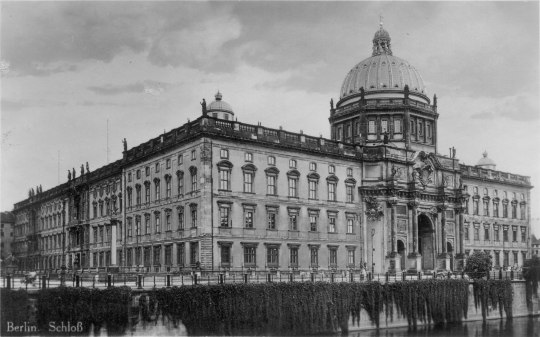
Photo of the north-eastern front of the Stadtschloss in the 1920s.
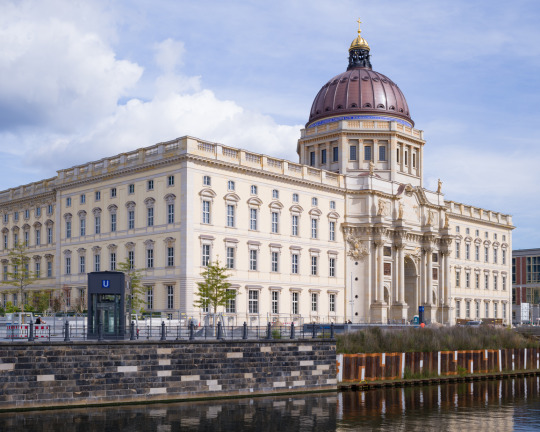
Photo of the north-eastern front of the Stadtschloss of September 2022, by Frank Schulenburg.
At present, it does not look like it. When Prinz Ferfried von Hohenzollern died about a month ago, there were no reports of the White Lady having made an appearance. But who knows? Perhaps on a dark autumnal night, as the street lanterns cast a sparse glimmer over the river Spree, and not a light shines from the windows of the new Stadtschloss, you might be (un-)lucky enough to spy her...?
...But always remember that if you do, you're most likely to have encountered a modern-day Philippinette.
Happy Halloween, everyone!
#halloween#spooky season#history#17th century#18th century#ghost stories#ghosts#weiße frau#white lady#karl ludwig von der pfalz#liselotte#liselotte von der pfalz#friedrich wilhelm i#friedrich i#sophie luise von mecklenburg-schwerin#kunigunde von orlamünde#anna von sydow#saint cloud#berlin#stadtschloss#myths and legends#german history#french history#my history posts
71 notes
·
View notes
Text


Fulda Stadtschloss (City Palace) by day and by night.
Fulda, Germany
#architecture#architecture photography#historic#historic building#historic place#baroque#baroque architecture#night#night photography#lights#city#palace#city palace#Stadtschloss#photographer on tumblr#Fulda Stadtschloss#Fulda city palace#Fulda#Germany
24 notes
·
View notes
Video
youtube
Das Berliner Stadtschloss 2022
Es gibt immer noch Bauarbeiten rund um das neue Stadtschloss von Berlin. Die Einheitswippe für das Gedenken der friedlichen Revolution im Herbst 1989 ist noch im Bau und wird voraussichtlich 2023 fertiggestellt. Trotzdem lohnt sich ein Spaziergang rund um das Humboldt-Forum mit dem Charme des alten Stadtschlosses.
#Berlin#Berliner Stadtschloss#Stadtschloss#Wiederaufbau#news#FFB#Fernsehfunk Berlin#aktuell#architektur#Stadtmitte#zentrum#Humboldt-Forum
3 notes
·
View notes
Video
`Schloss' & Dom by Pascal Volk
#Berlin#Berlin Mitte#Europe#Germany#Mitte#Rathausstraße#Stadtschloss#Humboldt Forum#Palace#Palacio Real#Berliner Dom#Berlin Cathedral#Catedral de Berlín#Spree#Fluss#River#Río#Nacht#Night#Noche#Langzeitbelichtung#Bulb#long-exposure#Larga exposición#slow shutter#Spiegelung#Reflexion#Reflection#Reflexión#Reflejo
0 notes
Text
instagram
The rebuilt Berlin City Palace (aka Humboldt-Forum) in the evening sun.
Some Prussian Glory to gild your weekend :)
#Berlin#Germany#Deutschland#Prussia#Preussen#Stadtschloss#Humboldt Forum#Autumn#Herbst#Abendsonne#Evening sun#Instagram
1 note
·
View note
Photo
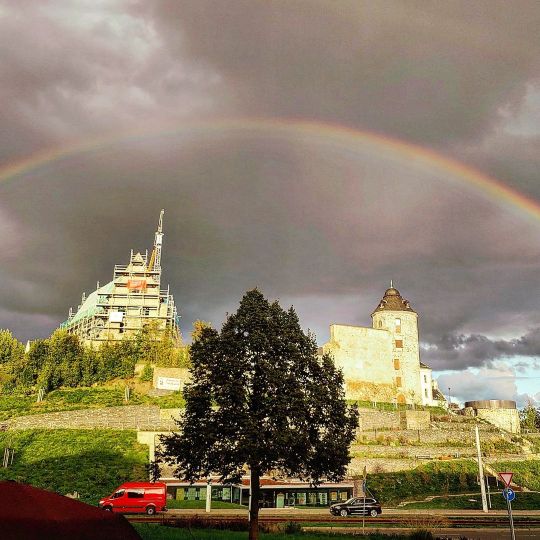
#900jahreplauen #regenbogen🌈 über dem #stadtschloss #plauenvogtland (hier: Plauen) https://www.instagram.com/p/CjBMZAdN0N1/?igshid=NGJjMDIxMWI=
0 notes
Video
Schlossplatz by S. Dekind
Via Flickr:
Berlin-Mitte 10-2015
0 notes
Photo

Humboldt Forum, Stadtschloss in Berlin, Germany… . . . . . . #humboldtforum #humboldt #stadtschloss #stadtschlossberlin #berlin #germany #europe #architecture #berlinberlin #berlincity #berlintrip #berlintravel #centralberlin #ronny_rose_photography #archtecturelovers #architecturephotography #photography #bnw #blackandwhitephotography #bnwphotography #art #fineartphotography #prints #printsforsale #postcard #postcardplaces #berlinmitte #travel #travelblogger #travelling (hier: Humboldt Forum) https://www.instagram.com/p/CetEm6Toqob/?igshid=NGJjMDIxMWI=
#humboldtforum#humboldt#stadtschloss#stadtschlossberlin#berlin#germany#europe#architecture#berlinberlin#berlincity#berlintrip#berlintravel#centralberlin#ronny_rose_photography#archtecturelovers#architecturephotography#photography#bnw#blackandwhitephotography#bnwphotography#art#fineartphotography#prints#printsforsale#postcard#postcardplaces#berlinmitte#travel#travelblogger#travelling
1 note
·
View note
Text


Dusk in the historic city centre of Potsdam.
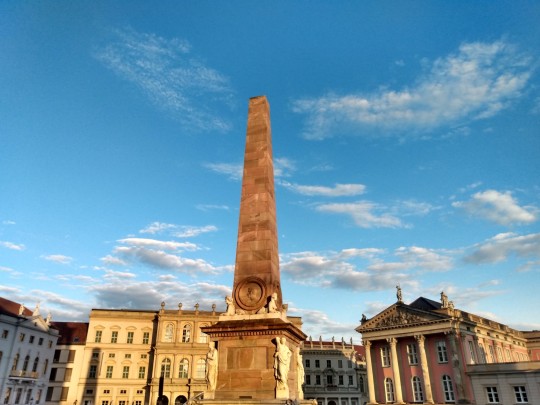
#my pics#potsdam#potsdamer stadtschloss#alter markt#architecture photography#photography#history#18th century#friedrich der große#frederick the great
16 notes
·
View notes
Text
Tafeln wie beim König von Preußen - KPM BERLIN Breslauer Stadtschloss: Düsseldorf bis 28.08.2022
Tafeln wie beim König von Preußen – KPM BERLIN Breslauer Stadtschloss: Düsseldorf bis 28.08.2022
König Friedrich II. von Preußen, der von der Geschichte mit dem Beinamen „der Große“ bedacht wurde, war auch einer der größten Porzellan-Liebhaber aller Zeiten. 1763 erwarb Friedrich vom Kaufmann Johann Ernst Gotzkowsky die Berliner Porzellanmanufaktur. Er nannte sie KÖNIGLICHE PORZELLAN-MANUFAKTUR BERLIN – die KPM produziert bis heute.
© Landeshauptstadt Düsseldorf/David Young
Der König hatte…

View On WordPress
#Berliner Porzellanmanufaktur#Breslauer Stadtschloss#Düsseldorf#Friedrich Elias Meyer#Hetjens - Deutsches Keramikmuseum#Johann Joachim Kändler#KÖNIGLICHE PORZELLAN-MANUFAKTUR BERLIN#König Friedrich II. von Preußen#KPM#Manufaktur#Modelleur#Porzellan#Rocaille
1 note
·
View note
Text







Portal at the Stadtschloss, Weimar, Germany - Helga Blocksdorf Architektur
#Helga Blocksdorf Architektur#architecture#design#building#modern architecture#interiors#minimal#timber#wood#wood architecture#arches#metal roof#castle#museum#entrance#old and new#extension#cool architecture#beautiful places#germany
126 notes
·
View notes
Video
Potsdamer Stadtschloss by Pascal Volk
Via Flickr:
Sitz des Landtags Brandenburg
#Brandenburg#Breite Straße#Europe#Germany#Potsdam#Potsdamer Stadtschloss#City Palace#Palacio de la Ciudad#15mm#Wide Angle#Weitwinkel#gran angular#super wide angle#Superweitwinkel#ultra wide angle#Ultraweitwinkel#ww#wa#sww#swa#uww#uwa#Herbst#fall#autumn#otoño#Architecture#Architektur#arquitectura#Canon EOS R3
0 notes
Text
instagram
New Pace Potsdam/Brandenburg
Some Prussian Glory to gild your weekend :)
#Instagram#Prussia#Preußen#New Palace Potsdam#Neues Stadtschloss Potsdam#Brandenburg#Deutschland#Germany
4 notes
·
View notes
Photo

Hans Olde
Der Schnitter
1893
Museum im Weimarer Stadtschloss
https://de.wikipedia.org/wiki/Hans_Olde
29 notes
·
View notes
